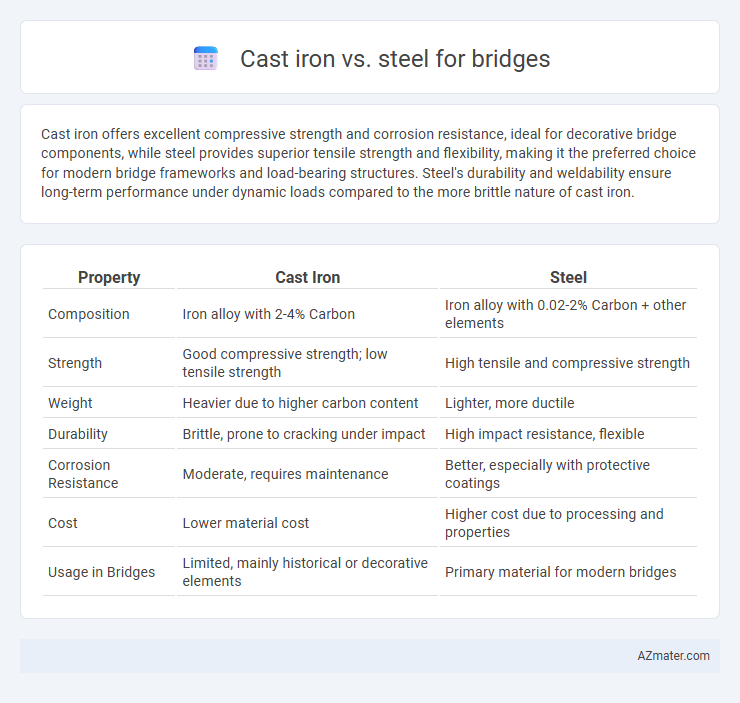Cast iron offers excellent compressive strength and corrosion resistance, ideal for decorative bridge components, while steel provides superior tensile strength and flexibility, making it the preferred choice for modern bridge frameworks and load-bearing structures. Steel's durability and weldability ensure long-term performance under dynamic loads compared to the more brittle nature of cast iron.
Table of Comparison
| Property | Cast Iron | Steel |
|---|---|---|
| Composition | Iron alloy with 2-4% Carbon | Iron alloy with 0.02-2% Carbon + other elements |
| Strength | Good compressive strength; low tensile strength | High tensile and compressive strength |
| Weight | Heavier due to higher carbon content | Lighter, more ductile |
| Durability | Brittle, prone to cracking under impact | High impact resistance, flexible |
| Corrosion Resistance | Moderate, requires maintenance | Better, especially with protective coatings |
| Cost | Lower material cost | Higher cost due to processing and properties |
| Usage in Bridges | Limited, mainly historical or decorative elements | Primary material for modern bridges |
Introduction to Bridge Materials
Cast iron and steel serve as fundamental materials in bridge construction, each offering distinct mechanical properties that influence structural performance and design. Cast iron is characterized by its high compressive strength and excellent durability but lacks tensile strength, making it suitable for arches and compression members in older bridge designs. Steel, with superior tensile strength, flexibility, and resistance to fatigue, has become the preferred material for modern bridges, enabling longer spans and greater load capacities while allowing for innovative architectural forms.
Overview of Cast Iron and Steel
Cast iron exhibits high compressive strength and excellent resistance to corrosion, making it suitable for bridge components subject to heavy loads and weather exposure. Steel provides superior tensile strength and ductility, allowing for longer spans and more flexible design options in bridge construction. Both materials play critical roles in structural integrity, with steel dominating modern bridge engineering due to its toughness and weldability.
Mechanical Properties Comparison
Cast iron exhibits high compressive strength and excellent wear resistance but lacks tensile strength and ductility, making it brittle under tension. Steel offers superior tensile strength, ductility, and toughness, enabling it to absorb dynamic loads and resist fatigue effectively in bridge construction. The mechanical property differences dictate that steel is the preferred material for modern bridges requiring flexibility and load-bearing capacity, while cast iron is often limited to decorative or secondary structural elements.
Durability and Lifespan
Cast iron offers high compressive strength but is brittle, making it less durable under dynamic loads typically experienced by bridges. Steel provides superior tensile strength and flexibility, resulting in greater durability and a longer lifespan for bridge structures, often exceeding 100 years with proper maintenance. The enhanced resistance to fatigue and corrosion in steel ensures sustained performance in varying environmental conditions.
Weight and Load-Bearing Capacity
Cast iron offers high compressive strength but is brittle and heavier than steel, limiting its load-bearing capacity under dynamic stresses in bridge construction. Steel provides superior tensile strength, is lighter, and supports greater load-bearing capacity with flexibility, making it the preferred material for modern bridges. The weight-to-strength ratio of steel enhances structural efficiency and durability compared to cast iron.
Corrosion Resistance
Cast iron exhibits moderate corrosion resistance due to its high carbon content forming a protective oxide layer, but it remains susceptible to rust and structural degradation in harsh environments. Steel, especially weathering steel and stainless steel alloys, offers superior corrosion resistance by developing a stable oxide patina or containing chromium, which inhibits rust formation and enhances durability. In bridge construction, steel is preferred over cast iron for long-term performance and reduced maintenance costs related to corrosion control.
Cost and Economic Considerations
Cast iron bridges generally incur lower initial material costs due to the abundance and simpler casting processes, but their brittleness may lead to higher maintenance expenses over time. Steel offers greater strength and flexibility, translating to longer lifespan and potentially lower lifecycle costs despite higher upfront investment. Economic evaluations often favor steel for large-scale bridges where durability and reduced repair frequency optimize total cost of ownership.
Construction and Maintenance Issues
Cast iron's brittleness and low tensile strength limit its use in bridge construction, making it more prone to cracking under dynamic loads, whereas steel's higher tensile strength and ductility provide superior durability and load-bearing capacity. Steel bridges require regular maintenance to prevent corrosion through protective coatings and inspections, while cast iron structures often face more challenging and costly repairs due to their susceptibility to fracture and difficulty in welding. The construction process favors steel for its weldability and flexibility in design, enabling easier assembly and modifications compared to the rigid, cast components typical of cast iron bridges.
Historical and Modern Applications
Cast iron, known for its high compressive strength and brittleness, was extensively used in 18th and 19th-century bridge construction, exemplified by the Iron Bridge in Shropshire, England, built in 1779 as the first major cast iron bridge. Steel, offering superior tensile strength and ductility, became the preferred material in the late 19th and 20th centuries, enabling longer spans and more flexible designs seen in iconic structures like the Brooklyn Bridge and modern cable-stayed bridges. Contemporary bridge engineering favors high-strength steel alloys and composite materials for durability, seismic resistance, and reduced maintenance, while cast iron remains limited to decorative and repair purposes due to its structural limitations.
Conclusion: Choosing the Right Material
Steel offers superior tensile strength, flexibility, and durability, making it the preferred choice for modern bridge construction that requires long spans and dynamic load handling. Cast iron provides excellent compressive strength and corrosion resistance but is brittle and less reliable under tension, limiting its use to historic or decorative bridge components. Selecting between cast iron and steel depends on structural requirements, budget constraints, and maintenance considerations, with steel typically delivering better performance and longevity for contemporary bridges.

Infographic: Cast iron vs Steel for Bridge
 azmater.com
azmater.com